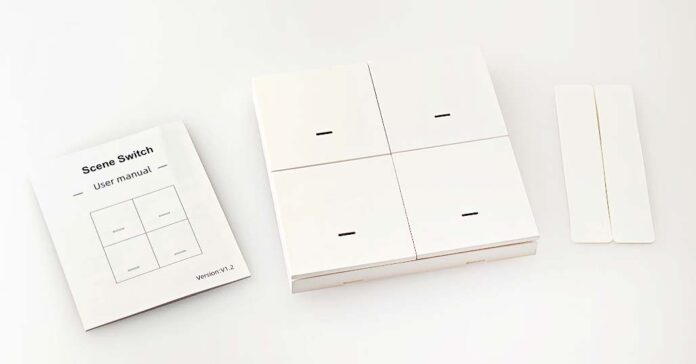I got this wireless Zigbee light switch form AliExpress a few months ago, and I truly have mixed feelings about it. This 4-button square remote scene switch is a cheap alternative to traditional light switches which lets you activate up to 12 different actions using it, and while it has its own downsides, it’s also among the most affordable options from this product category. Let’s get into more details!
Why you can trust us: We test all of our products according to the techtactician consumer usability benchmark methodology which evaluates all of the product characteristics that matter to the user in day to day use. Enjoy the review!
This web portal is reader-supported, and is a part of the Aliexpress Partner Program, Amazon Services LLC Associates Program and the eBay Partner Network. When you buy using links on our site, we may earn an affiliate commission!
One important thing: The name “TS0044” doesn’t only refer to our Tuya “ZG_101ZS” scene switch. It’s also used for other devices based on the same chipset, which include a different version of this switch design also sold the Tuya and Moes brands (you can view it here on Amazon), as well as variations on this 4-button control layout (notably the Tuya TS0044_1 remote which I have already reviewed).
The name “ZG_101ZS”, while not present anywhere in the AliExpress listing and in Zigbee2MQTT (Z2M) where the product is referred to simply as “TS0044”, was clearly stated both on the product box, inside the instruction manual, and on the switch itself.
ZG_101ZS/TS0044 Wall Switch Specification
Here are all of the specs of this particular version of the TS0044 switch, taken straight out of the instruction manual included in the package.
| Device: | TS0044 / ZG_101ZS Zigbee 4-Button Wall Scene Switch |
|---|---|
| Photo: |
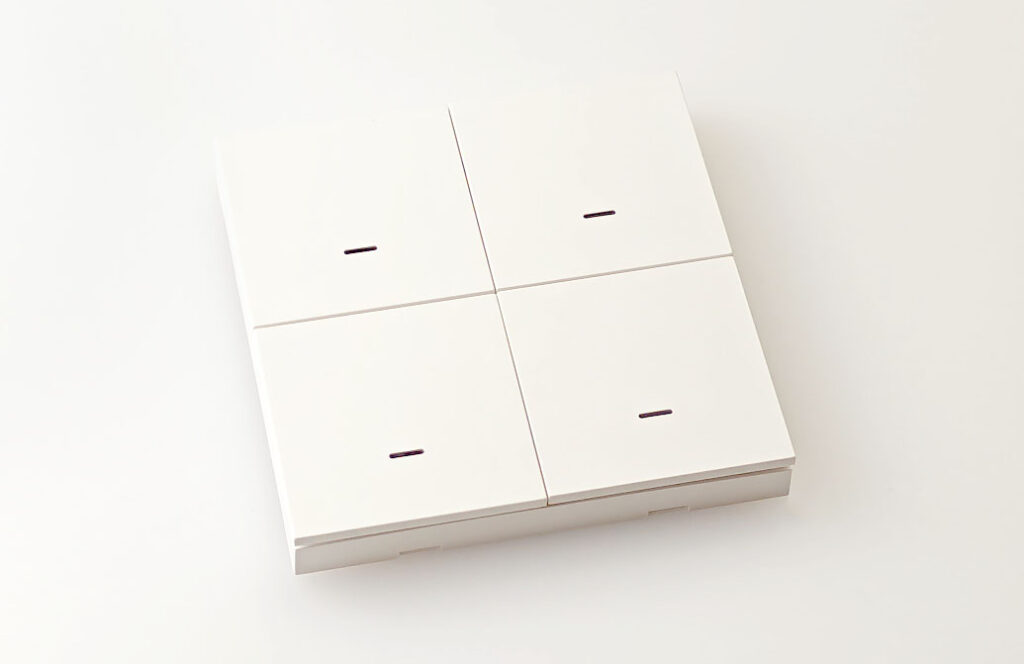 |
| Price & availability: | |
| Input power: | 2x CR2032 3V or 2x CR2016 batteries (get them here) |
| Comm. protocol: | ZigBee 3.0 |
| Dimensions: | 86 x 86 x 13mm |
| Standby current: | 5µA |
| Working temperatures: | -10°C-55°C |
| Working humidity: | <95%RH |
| Additional accessories: | Two mounting stickers |
My General Experience With The ZG_101ZS
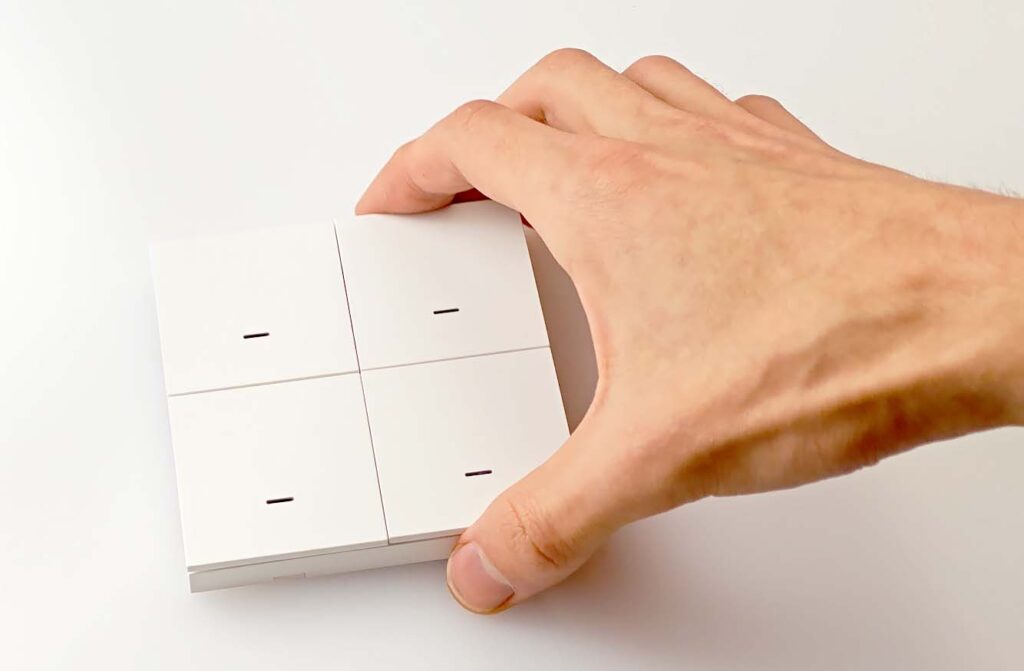
The ZG_101ZS has been a part of my smart home setup for quite a while, and during that time I had enough experience with it to give you a neat report on what it does well, and where it absolutely falls short for me.
I used this as my main office wall light switch for about two weeks, mounted on a custom 3D-printed light switch cover. It was a temporary solution to hide the master switch on the wall and attach the new wireless one, until I was ready to replace the master switch itself.
In general, it worked rather well – 3 standard actions per button (single click, double click and button hold) triggered without any trouble, and the green LED lights which come on when a button is pressed were dim and non-distracting. I also didn’t notice any abnormal battery drain, although note that I’ve been using the button for a relatively short period of time. Here are some other things I’ve noticed.
The Button Travel and Some Side-Click Issues
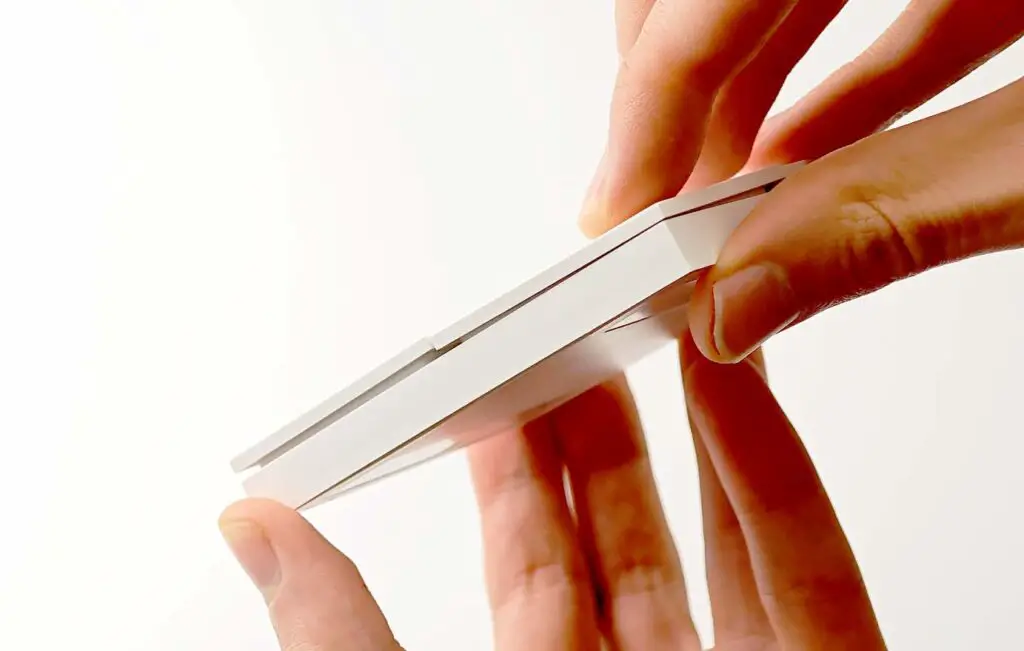
The buttons are clicky and reasonably responsive, although there is a non-zero chance of you pressing one of the buttons a little bit too off-center and it not registering a press. This happened to me a few times, but was rare enough not to be a real issue.
Take a look at the image above – it shows the button travel when it’s pressed on one of its corners, rather than in the middle.
With long button press actions it’s the same deal as on many devices of this type: the long press is around 3 seconds long, and registers only once you let go of the button.
The switch is very thin, so it’s perfect to fix it to a wall or other flat surface – and that’s exactly what the two adhesive strips bundled with the device are for. Bonus points for that.
The device can be rather easily opened using a flat screwdriver as shown on the image below. We will get to what’s inside in just a moment.
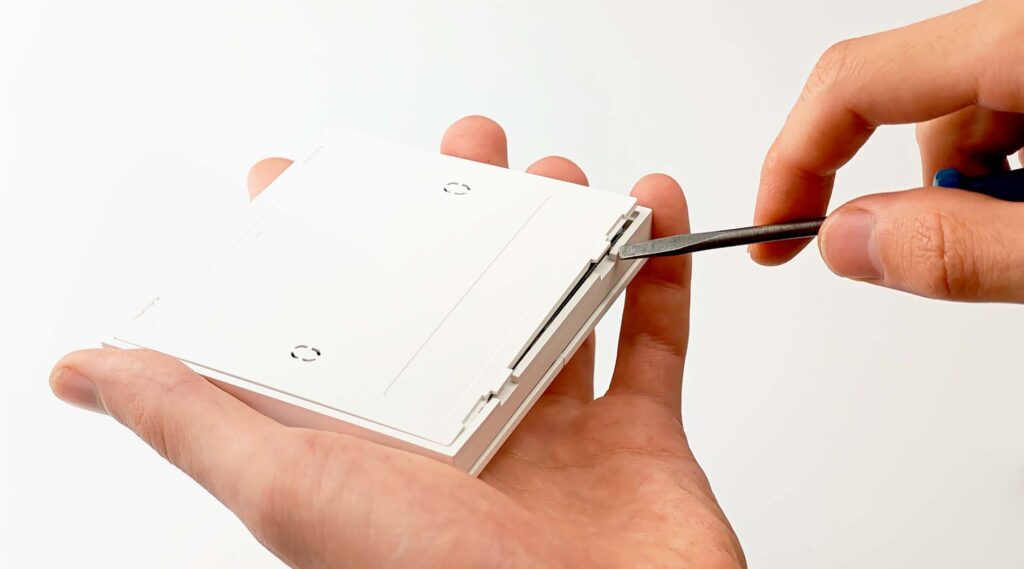
What I’ve also noticed in my particular setup (the button being connected to my Home Assistant setup via Zigbee2MQTT) is that many times over the first button I pressed after not using the switch for some time wouldn’t actually register the click and trigger its action, forcing me to press it once again to turn my office lights on.
My first guess was that for some reason the switch entered some kind of sleep mode once it had waited for the input for too long, and it did require an additional press to wake it up, perhaps as a measure to extend battery life.
It turns out however, that it’s a well known issue with many of these devices, with some people reporting successful makeshift fixes for it. As in my case I didn’t attempt to troubleshoot this issue further, I’ll just leave it at that.
With the switch supporting double press actions, this was the thing that bothered me the most with this one. Other than that, the switch did its job rather well, and was pretty pleasant to use.
Opening The Switch, and The Required Batteries
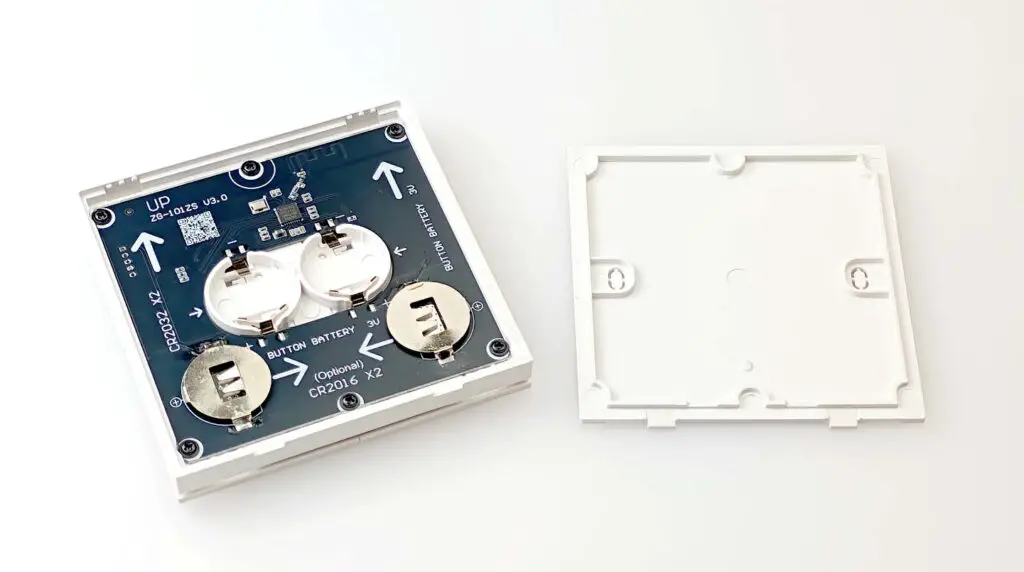
Opening up our scene switch reveals a rather neatly designed PCB with the device’s name printed on, and 4 button battery slots, two main ones, and two labeled as optional. It’s fixed to the front panel with 6 small screws.
The two main slots are meant for standard CR2032 button batteries, and the optional slots are for the CR2016 batteries. According to the manual, you can use the switch with either cell type. I personally haven’t tried using it with both battery pairs in, but in theory, it should be possible.
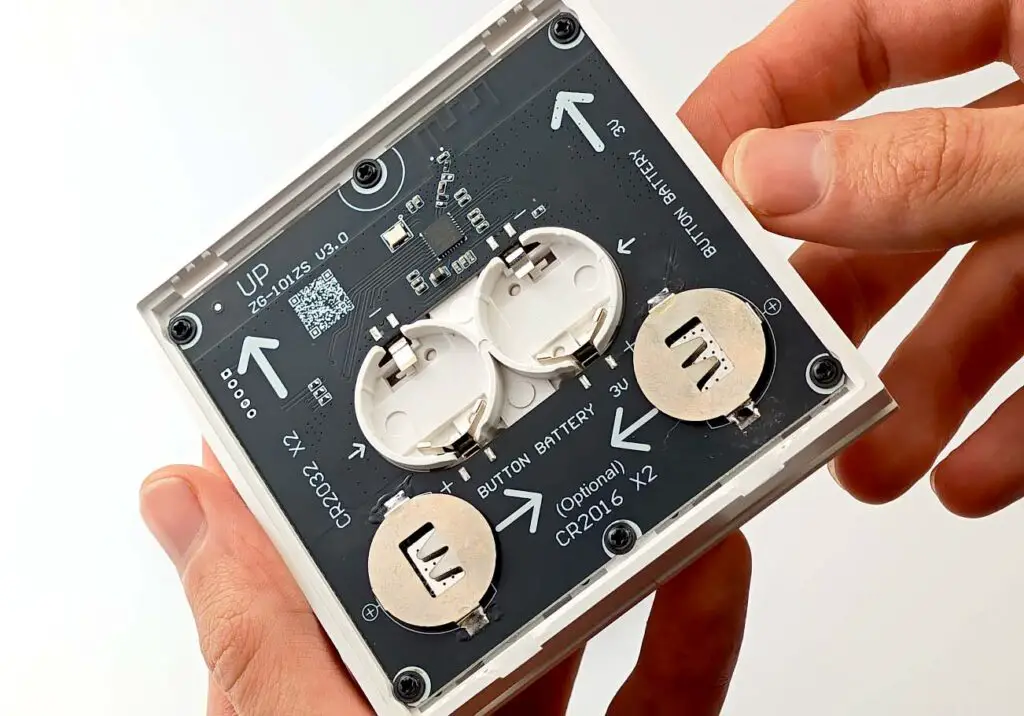
After inserting the batteries, you can make the device enter the pairing mode by pressing the bottom left button for 10 seconds, until the lights on the switch come up.
Remember that the “TS0044” devices are known to have issues with cheaper 2032 bateries with insufficient voltage to successfully go through the Z2M pairing process. If you have any pairing issues, try using a different new set of batteries.
In my case, the switch came without the batteries, unlike the TS0044_1 remote that I’ve reviewed a few days ago.
How Home Assistant / Zigbee2MQTT See The ZG_101ZS Switch
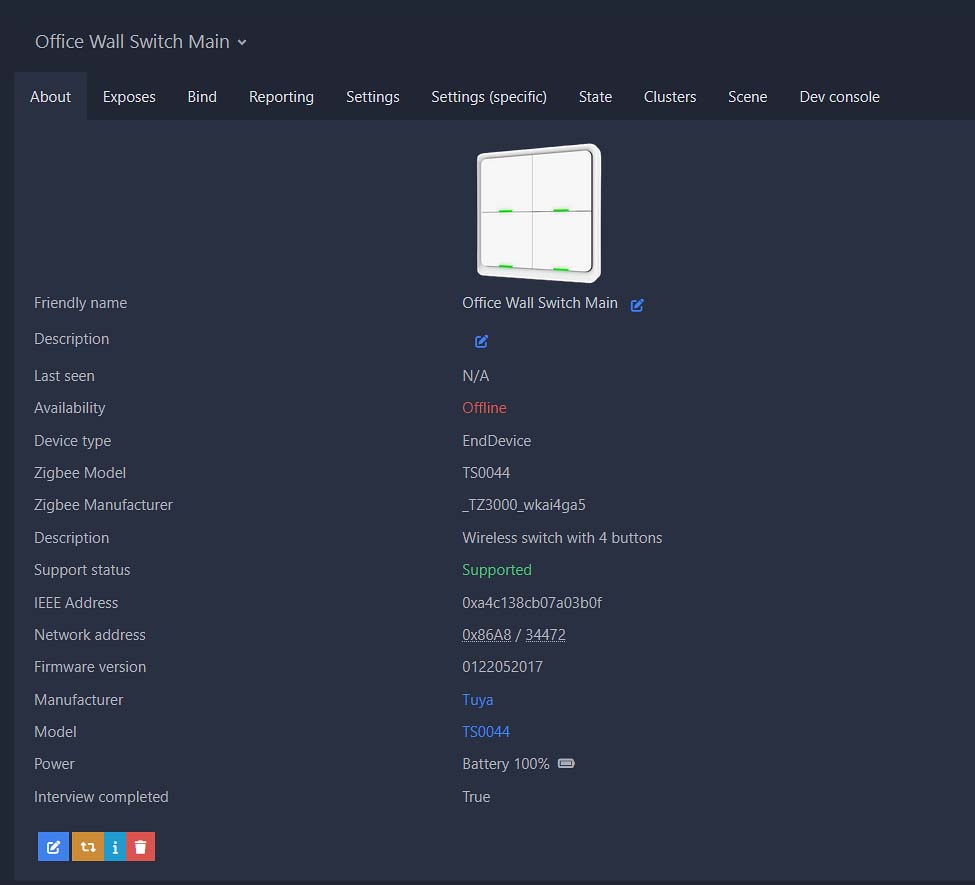
Zigbee2MQTT sees the ZG_101ZS scene switch as a Tuya device, model “TS0044”, as I’ve already mentioned before. The model name present inside the instruction manual and on the device however, doesn’t appear anywhere in the software.
In my testing setup, all of the Z2M devices including this wall switch are connected to a single ZB-GW04 gateway, which you can still get from AliExpress for about $10.
The available trigger actions for this device are the exact same as for other 4-button wireless switches and remotes (single press, double press, hold).
Seeing many other offers including devices that look almost exactly the same as this one that are also available on AliExpress (for example here), it doesn’t come off as a surprise that a slightly different looking version of this very same switch is used as the main device image in Z2M as you can see above.
The Verdict – Was It Worth The $10 I Paid For It?

So, in the end, is this one worth getting? With its cost usually floating around the $10 mark, it’s hard to argue that it’s one of the cheapest 4-button Zigbee wall light switches you can come across both on AliExpress, Amazon and eBay. With that in mind, it’s a matter of deciding whether or not you can live with the few of its shortcomings including the first button press occasionally not registering for some people.
My final verdict is – it’s a neat device for the price, and provided the first button click issue can be fixed (and as you might have seen in the linked sources above, some people were able to fix it), it’s a pretty good for a budget wall mounted scene switcher with decent design and looks.
It’s always important to remember that the other versions of this switch (including this one here) might be also a good option to consider. With a plenty of these devices out there, there are a lot of alternatives to test out.
Hope that this short review was helpful, and see you again in another one!
You can check my full review of the TS0044_1 remote I’ve mentioned a few times in this article here: Tuya TS0044_1 Zigbee Remote From Aliexpress – Hands-On Review

